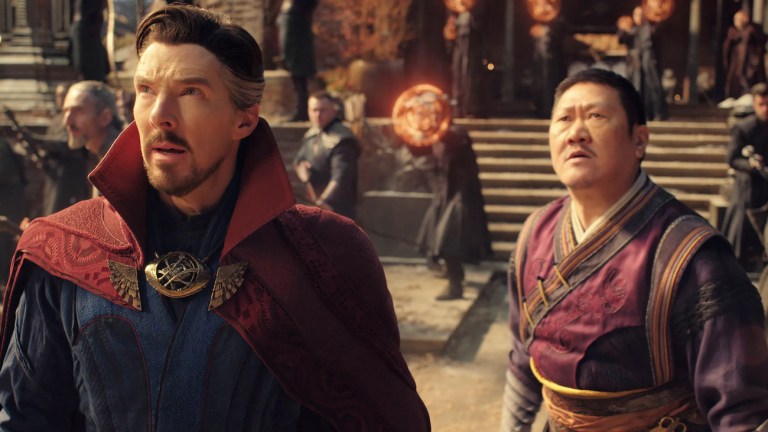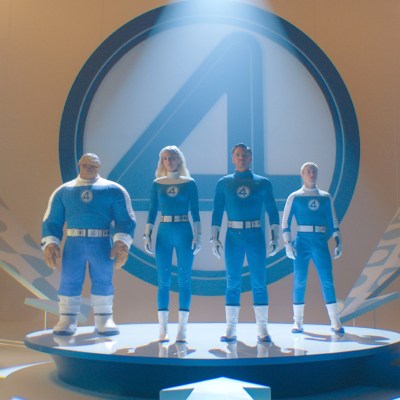Marvel Studios and the Curse of High Expectations
As Marvel moves deeper into Phase 4, fan and industry expectations are causing concern.

Marvel Studios is doomed.
That’s right: according to some cynical industry chatter—heard on recent podcasts and seen in this self-satisfied piece, in which the writer actually consults his “cousin Vinny from the Bronx” for his insights into the Disney-owned studio—Marvel Studios is teetering on the edge of disaster. Kevin Feige should resign now, and Disney might want to start thinking about finding a new tenant for Marvel’s offices on the company’s Burbank lot.
That’s at least the tone, and all because Doctor Strange in the Multiverse of Madness, which has made more than $700 million worldwide in just two weeks of release (more than the first Doctor Strange’s total box office haul) is somehow a failure.
You heard me: a movie that’s sure to end its box office run somewhere around the $900 million mark, a movie starring two Marvel B-listers that will end up grossing more than The Batman, is a dud.
Now, reasonable people can certainly debate the artistic and narrative merits of Doctor Strange 2, as well as whether Sam Raimi’s directorial style fits the Marvel Cinematic Universe and if the film moves the MCU forward as a whole.
And to be sure, the film’s B+ rating on CinemaScore (only the third Marvel film to receive that, with all other MCU movies earning an A or A+) and heartstopping 67 percent box office drop in its second weekend are signs that this film isn’t going to be as universally loved as, say, Captain America: Civil War or Spider-Man: No Way Home. It also follows three previous MCU movies—Black Widow, Shang-Chi and the Legend of the Ten Rings, and Eternals—that didn’t exactly blow the doors off theaters.
But our guess is that Marvel is going to be okay and that Feige isn’t frantically sending tractor trailers full of money to the front yards of Robert Downey Jr. and Chris Evans just yet. If anything, Marvel is now the victim of incredibly high expectations, both on the creative and financial fronts, and anything not meeting those standards is somehow deemed a calamity, which is admittedly not a healthy thing.
The Billion Dollar Box Office Snare
There’s no question that Marvel Studios and the MCU have had in their first decade a box office run unprecedented in the history of Hollywood. While including the Spider-Man films co-produced with Sony Pictures, the MCU has had 28 straight movies debut at number one at the box office over the course of 14 years. All but six have earned more than $500 million worldwide at the box office, while 10 of those films are members of the $1 billion club.
Stop a minute: we said 10 MCU movies have made a billion or more at the box office, right? Those include all four Avengers movies, two of the Spider-Man outings, Captain America: Civil War (which is kind of an Avengers movie, really), Black Panther, Iron Man 3, and Captain Marvel.
There are specific reasons why all 10 of those movies made billions of dollars. The Avengers films, especially the last two, teamed everyone from the other movies and, again in the case of the last two, brought a massive narrative arc to a close. Spider-Man, always Marvel’s most popular character, got the MCU reboot fans had been waiting for. Black Panther and Captain Marvel represented cultural game-changers for representation in the MCU and Hollywood blockbusters at-large.
Among the movies that didn’t make a billion or more: the first few Iron Man, Captain America, and Thor films; both Guardians of the Galaxy entries; the first Doctor Strange; Spider-Man: Homecoming; both Ant-Man films… you get the picture. Simply put, not everything Marvel releases is going to hit that billion-dollar home run. Not everything in the canon has the same widespread appeal or zeitgeist-capturing subject matter to get to that point.
Doctor Strange 2 is a gigantic hit already because it’s built on the success of the character’s previous outings and the enthusiasm for WandaVision. To somehow suggest it falls short because it doesn’t hit the same heights as an Avengers movie is, pardon the expression, madness. Same goes for Shang-Chi and Eternals, which—while definitely on the lower end of the MCU box office scale—managed to do decent numbers in the midst of a pandemic and while introducing all-new characters and settings.
Do you think Ant-Man and the Wasp: Quantumania or Thor: Love and Thunder will hit a billion? Unlikely, although anything’s possible. Can Black Panther: Wakanda Forever get there without Chadwick Boseman? Unknown. We’re pretty sure all three will do just fine whether they get past the billion-mark or not. But to use that now as the benchmark for either total success or total failure is a standard that no studio, not even the mighty Marvel, can hope to reach every time.
Building a New Saga
It’s worth noting that Phase 1 of the MCU, which wasn’t even called Phase 1 back then, did not exactly knock anyone’s socks off. Yes, the first Iron Man was a surprise smash out of the box. Nobody expected a B-list hero played by a fading actor with numerous personal problems to haul in $585 million worldwide. But The Incredible Hulk was pretty much Marvel’s one real dud to date ($265 million) and neither Thor ($449 million) nor Captain America: The First Avenger ($370 million) even reached the $500 million mark.
Back then, there were doubts about Marvel’s strategy, and plenty of critics (both mainstream and the nerdier, Marvel-friendly kind) questioned the idea of planting seeds for other movies in the films already produced. The joke at the time was that had either Thor or Captain America really tanked, The Avengers would have hurriedly been retitled Iron Man 3: The Avengers.
That didn’t happen, of course. The Avengers, the first time that multiple characters from different movies all came together in a single epic, vaulted Marvel to a whole new level, earning $1.5 billion globally and proving that the company’s creative ambitions were viable beyond any expectation.
At the same time, it started to become clear that Marvel was building a far-reaching narrative arc that would connect all its movies, but notably that arc didn’t truly come into focus until late in the game. Only diehard Marvel Comics fans recognized that ominous purple face that turned, grinning, to the camera during The Avengers’ mid-credits sequence.
While Thanos made two further cameos in Avengers: Age of Ultron and Guardians of the Galaxy, and the Infinity Stones showed up in a number of films, the real extent of Thanos’ plan and what the Stones meant to it was not fully laid out until Avengers: Infinity War, which was the first half of the conclusion of what had by then been deemed the Infinity Saga.
In other words, while diehard Marvel fans knew where things were possibly headed, most of the underlying story for the Infinity Saga was not readily apparent to the vast moviegoing audience that was by then plunking down those billions of dollars to see MCU movies.
The same could be said now: while the first few movies of Marvel’s Phase 4 have been criticized for not providing a clear picture of what the next overarching storyline is, the truth is that Phases 1 and 2 didn’t necessarily do that either, especially that first batch of films. Yet, frankly, the clues are there: The MCU is already exploring both the multiverse and alternate timelines with Spider-Man: No Way Home, Loki, and Doctor Strange 2, and hints have been dropped about the potential big bad, Kang the Conqueror.
Some of the upcoming films like Ant-Man and the Wasp: Quantumania and Fantastic Four will almost certainly deal with this narrative in a much more direct fashion, while others, such as Guardians Vol. 3, may only touch on it tangentially. That’s how Marvel did it before and that appears to be how they’re doing it now. By the time the studio gets to the heart of the next big crossover event, which many speculate will be a version of Secret Wars, the picture should be crystal clear.
‘Everything Seems to Work Out’
The line above is uttered by Thor in Thor: Ragnarok, a film that grossed $850 million worldwide after many had proclaimed the sub-franchise starring the God of Thunder to be deader than Elvis.
People and pop culture have short-term memories. We’re old enough to remember that Marvel Studios and the MCU took their time to find their footing in those early days, making plenty of mistakes along the way. But anyone in the industry or the public who is still coming off the financial and creative high of that last stretch of Phase 3, including the all-encompassing Endgame, may find themselves looking at an MCU they don’t quite recognize at the moment.
That’s because the MCU itself is rebuilding right now. Three of its biggest foundational stars (Downey, Evans, Johansson) are gone. The Avengers are in a state of flux. The universe itself has been irrevocably changed by the Snap and the introduction of the multiverse.
In the real world, events also took place that no one could see coming. We have no real idea how the onslaught of COVID affected plans for the MCU, except that all the momentum from 2019’s Endgame and Spider-Man: Far from Home was dissipated in the lost year of 2020. Marvel’s rollout of the Phase 4 slate at 2019’s Comic-Con seems like it happened 10 years ago. It’s a wonder that the studio has been able to, more or less, stick to what was promised that summer and more.
The loss of Chadwick Boseman was undoubtedly a major hit to the MCU architecture as well. The tragic personal loss for his family and friends aside, T’Challa was supposed to be a cornerstone of the universe going forward, alongside Doctor Strange and Captain Marvel. We have yet to see how that all plays out.
There’s also an argument to be made that Marvel tried to do too much, too soon as the pandemic began to wane. In addition to a full slate of three to four movies a year, the studio was tasked by its Disney corporate overlords to start pumping out TV shows as well. The quality of those shows and the response to them has been mixed. Could Feige and his team be stretched too thin? Again, possible.
Then there is the simple chance that the end of Phase 3 and the Infinity Saga marked the peak of Marvel’s popularity. Everything in life is cyclical, so millions and millions of audience members around the world who were invested in seeing the fates of Iron Man, Cap, and Thanos may have had enough at this point and are ready to move on to something different.
If that’s the case, then it’s not like Marvel Studios will go away anytime soon—the company may settle into a different niche. But that remains to be seen and will take several years of genuinely soft ticket sales and audience enthusiasm before it happens.
The last thing Feige should do now, and we know he knows this, is be reactionary. We still harbor suspicions that John Krasinski’s appearance as Reed Richards in Doctor Strange 2 was the Marvel Studios chief’s way of blowing a kiss to the fans who wanted to see that without committing to the prospect. If that truly is part of the long-term plan, so be it. But Feige has stuck to a vision all this time, and it has indeed worked out.
It’s way too early to count Marvel Studios out or even down. This is a studio that has, among other things, taken risks like creating a team of heroes last seen together in a cartoon, making a film starring a talking raccoon, putting one of its most powerful characters in a sitcom, and producing the world’s first all-Black superhero movie. Those gambles have paid off every single time. Let the naysayers prognosticate all they want. When you’re heading for $900 million off a dark fantasy movie starring a sorcerer and a witch, you’re still doing something right.


